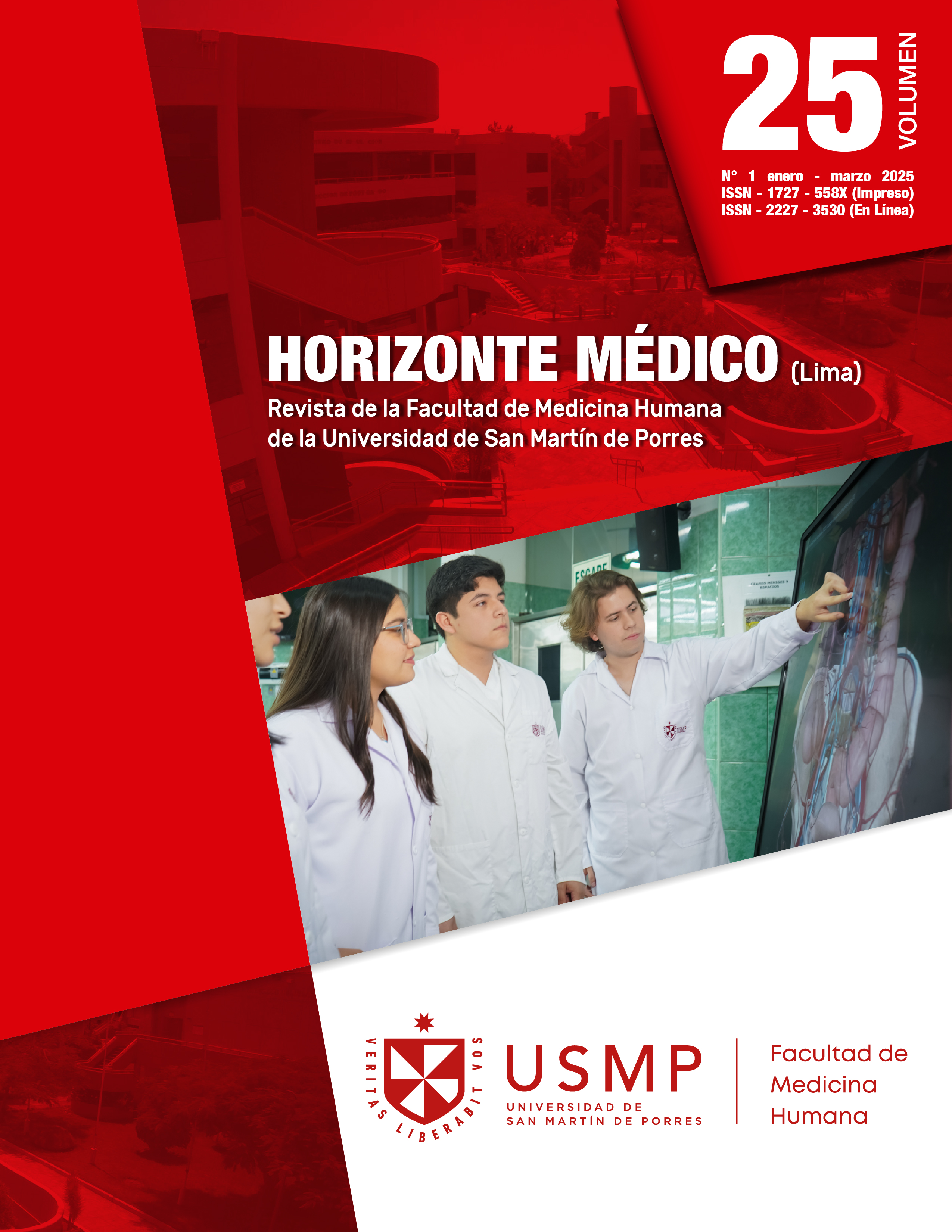Clinical and epidemiological characteristics of Guillain-Barré syndrome during the 2019 outbreak in a hospital in Chiclayo, Peru
DOI:
https://doi.org/10.24265/horizmed.2025.v25n1.10Keywords:
Guillain-Barre Syndrome , Epidemiological Monitoring , Signs and Symptoms , PeruAbstract
The objective is to describe the clinical and epidemiological characteristics of Guillain-Barré syndrome (GBS) during the 2019 outbreak in patients treated in a hospital in Chiclayo, Lambayeque, Peru. This is a descriptive and retrospective study conducted on 36 cases. Data were collected through a documentary analysis of clinical-epidemiological surveillance research forms for GBS, provided by the Ministry of Health. The sample was characterized by a median age of 46.05 years, a predominance of male sex (69.40 %) and an origin from Lambayeque (66.70 %). Additionally, 19.40 % of patients had chronic diseases, and the most frequent conditions found in their medical history were respiratory infections (45.50 %) and gastrointestinal infections (36.40 %). The clinical presentation was characterized by weakness (97.20 %), ascending paralysis (72.20 %), paresis of the left facial nerve (8.30 %), hyporeflexia (91.70 %) and decreased muscle tone (47.20 %). We conclude that male sex, an age between 30 and 59 years and a history of gastrointestinal and respiratory infections were the predominant epidemiological characteristics of GBS in this outbreak; while weakness, ascending paralysis, pain and hyporeflexia were among the most common clinical characteristics. Active surveillance and the strengthening of preventive and care capacities for this disease are recommended.
Downloads
References
Leonhard SE, Mandarakas MR, De Assis Aquino F, Bateman K, Brito Ferreira ML, Cornblath DR, et al. Guía basada en la evidencia. Diagnóstico y manejo del síndrome de Guillain-Barré en diez pasos. Medicina (Buenos Aires) [Internet]. 2021;81(5):817-36.
Phillips Morales Ó. Actualización en el síndrome de Guillain-Barré. Rev méd sinerg(San José, En línea)[Internet]. 2019;4(11):e290.
Vega-Fernández JA, Suclupe-Campos DO, Coico-Vega MM, AguilarGamboa FR. Viral etiology associated with Guillain-Barré syndrome: seeking an answer to the idiopathic. Rev Fac Med Humana [Internet]. 2022;22(3):584-96.
Carrera García L, Expósito Escudero JM, Natera de Benito D, Ortez C, Nascimento A. Neuropatías hereditarias y síndrome de Guillain-Barré. Protoc Diagn Ter Pediatr [Internet]. 2022;1:197-205.
Rigo D de FH, Ross C, Hofstatter LM, Ferreira MFAPL. Síndrome de Guillain Barré: perfil clínico epidemiológico e assistência de enfermagem: Guillain-Barré syndrome: epidemiological clinical profile and nursing care. Enferm Glob [Internet]. 2020;19(1):346–89.
Willison HJ, Jacobs BC, van Doorn PA. Guillain-Barré syndrome. Lancet [Internet]. 2016;388(10045):717–27.
Shahrizaila N, Lehmann HC, Kuwabara S. Guillain-Barré syndrome. Lancet [Internet]. 2021;397(10280):1214–28. Organización Mundial de la Salud. Síndrome de Guillain-Barré – Perú [Internet].
Ginebra: OMS; 2023. Disponible en: https://www.who.int/ es/emergencies/disease-outbreak-news/item/2023-DON477
Rodríguez-Morales AJ, Failoc-Rojas VE, Díaz-Vélez C. Gastrointestinal, respiratory and/or arboviral infections? What is the cause of the Guillain-Barré syndrome epidemics in Perú? Current status – 2019. Travel Med Infect Dis [Internet]. 2019;30:114–6.
La Industria. Incertidumbre y desinformación por casos de GuillainBarré [Internet]. Chiclayo: La Industria; 2019. Disponible en: http:// www.laindustriadechiclayo.pe/noticia/1560466405-incertidumbre-ydesinformacion-por-casos-de-guillain-barre
Munayco CV, Gavilan RG, Ramirez G, Loayza M, Miraval ML, Whitehouse E, et al. Large outbreak of Guillain-Barré syndrome, Peru, 2019. Emerg Infect Dis [Internet]. 2020;26(11):2778–80.
CDC-MINSA. Situación de síndrome de Guillain-Barré Perú [Internet]. Perú: CDC-MINSA; 2019. Disponible en: https://www.dge.gob.pe/ portal/docs/vigilancia/boletines/2019/35.pdf
Ballón-Manrique B, Campos-Ramos N. Características clínicas y paraclínicas del síndrome de Guillain-Barré en el Hospital Regional Lambayeque. Rev Neuropsiquiatr [Internet]. 2017;80(1):22-6.
Loayza Alarico MJ, De la Cruz Vargas JA, Alatrista Gutiérrez M del S. Síndrome de Guillain-Barré, brote epidémico en el Perú en junio de 2019. Salud Publica Mex [Internet]. 2019;61(5):556-7.
Vera O. Síndrome de Guillain-Barré. Cuad Hosp Clín [Internet]. 2019;60(2):59-64.
Soto-Cáceres V. Desastres naturales previsibles y prevenibles en el norte peruano: ¿cuándo estaremos todos juntos unidos trabajando para controlarlos? Rev Exp Med [Internet]. 2023; 9(1):1-2.
García Medina AJ, García Echevarría Y. Diplejía facial como forma de presentación del síndrome de Guillain-Barré. Rev Ciencias Médicas [Internet]. 2016;20(3):100–3.11. Ministerio de Salud. Alerta epidemiológica: incremento de casos de Guillain Barré en algunas regiones del país. Perú: MINSA; 2023. Disponible en: https://www.dge.gob.pe/epipublic/uploads/alertas/ alertas_202315_26_141558.pdf
Published
How to Cite
Issue
Section
License
Copyright (c) 1970 Horizonte Médico (Lima)

This work is licensed under a Creative Commons Attribution 4.0 International License.
Horizonte Médico (Lima) (Horiz. Med.) journal’s research outputs are published free of charge and are freely available to download under the open access model, aimed at disseminating works and experiences developed in biomedical and public health areas, both nationally and internationally, and promoting research in the different fields of human medicine. All manuscripts accepted and published in the journal are distributed free of charge under the terms of a Creative Commons license – Attribution 4.0 International (CC BY 4.0).


















